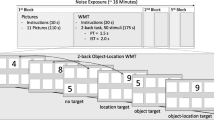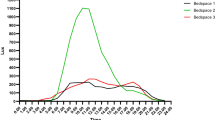Abstract
Quantitative data on the sensory environment of intensive care unit (ICU) patients and its potential link to increased risk of delirium is limited. We examined whether higher average sound and light levels in ICU environments are associated with delirium incidence. Over 111 million sound and light measurements from 143 patient stays in the surgical and trauma ICUs were collected using Quietyme® (Neshkoro, Wisconsin) sensors from May to July 2018 and analyzed. Sensory data were grouped into time of day, then normalized against their ICU environments, with Confusion Assessment Method (CAM-ICU) scores measured each shift. We then performed logistic regression analysis, adjusting for possible confounding variables. Lower morning sound averages (8 am-12 pm) (OR = 0.835, 95% OR CI = [0.746, 0.934], p = 0.002) and higher daytime sound averages (12 pm–6 pm) (OR = 1.157, 95% OR CI = [1.036, 1.292], p = 0.011) were associated with an increased odds of delirium incidence, while nighttime sound averages (10 pm-8 am) (OR = 0.990, 95% OR CI = [0.804, 1.221], p = 0.928) and the ICU light environment did not show statistical significance. Our results suggest an association between the ICU soundscape and the odds of developing delirium. This creates a future paradigm for studies of the ICU soundscape and lightscape.


Similar content being viewed by others
Data availability
By request to the corresponding author.
References
Girard, T.D., Pandharipande, P.P., Ely, E.W. Delirium in the intensive care unit. Crit Care 2008;12 S3. https://doi.org/10.1186/cc6149.
Norman, B.C., Jackson, J.C., Graves, J.A., Girard, T.D., Pandharipande, P.P., Brummel, N.E., et al. Employment Outcomes After Critical Illness: An Analysis of the Bringing to Light the Risk Factors and Incidence of Neuropsychological Dysfunction in ICU Survivors Cohort. Crit Care Med 2016;44:2003-9. https://doi.org/10.1097/ccm.0000000000001849.
Pandharipande, P.P., Girard, T.D., Jackson, J.C., Morandi, A., Thompson, J.L., Pun, B.T., et al. Long-Term Cognitive Impairment after Critical Illness. N Engl J Med 2013;369:1306-16. https://doi.org/10.1056/NEJMoa1301372.
Environmental Protection Agency, Washington DC. Information on Levels of Environmental Noise Requisite to Protect Public Health and Welfare with an Adequate Margin of Safety, http://www.nonoise.org/library/levels74/levels74.htm; 1974 [accessed 28 July 2019].
Basner, M., Babisch, W., Davis, A., Brink, M., Clark, C., Janssen, S., et al. Auditory and non-auditory effects of noise on health. Lancet 2014;383:1325-32. https://doi.org/10.1016/s0140-6736(13)61613-x.
Watson, P.L., Ceriana, P., Fanfulla, F.. Delirium: is sleep important? Best Pract Res Clin Anaesthesiol 2012; 26:355-66. https://doi.org/10.1016/j.bpa.2012.08.005.
Kamdar, B.B., Needham, D.M., Collop, N.A.. Sleep deprivation in critical illness: its role in physical and psychological recovery. J Intensive Care Med 2012;27:97-111. https://doi.org/10.1177/0885066610394322.
Brummel, N.E., Girard, T.D.. Preventing delirium in the intensive care unit. Crit Care Clin 2013;29:51-65. https://doi.org/10.1016/j.ccc.2012.10.007.
Boivin, D.B., Duffy, J.F., Kronauer, R.E., Czeisler, C.A.. Dose-response relationships for resetting of human circadian clock by light. Nature 1996;379:540-2. https://doi.org/10.1038/379540a0.
Freedman, N.S., Kotzer, N., Schwab, R.J.. Patient perception of sleep quality and etiology of sleep disruption in the intensive care unit. Am J Respir Crit Care Med 1999;159:1155-62. https://doi.org/10.1164/ajrccm.159.4.9806141.
The National Institute for Occupational Safety and Health, https://www.cdc.gov/niosh/topics/noise/reducenoiseexposure/regsguidance.html; [accessed 10 June 2021].
International Electrotechnical Commission. International Standard, Medical electrical equipment, https://webstore.iec.ch/publication/67388; [accessed 10 June 2021].
Darbyshire, J.L., Young, J.D.. An investigation of sound levels on intensive care units with reference to the WHO guidelines. Crit Care 2013;17:R187. https://doi.org/10.1186/cc12870.
Tainter, C.R., Levine, A.R., Quraishi, S.A., Butterly, A.D., Stahl, D.L., Eikermann, M., et al. Noise Levels in Surgical ICUs Are Consistently Above Recommended Standards. Crit Care Med 2016;44:147-152. https://doi.org/10.1097/ccm.0000000000001378.
van de Pol, I., van Iterson, M., Maaskant, J.. Effect of nocturnal sound reduction on the incidence of delirium in intensive care unit patients: An interrupted time series analysis. Intensive Crit Care Nurs 2017;41:18-25. https://doi.org/10.1016/j.iccn.2017.01.008.
Kawai, Y., Weatherhead, J.R., Traube, C., Owens, T.A., Shaw, B.E., Fraser, E.J., et al. Quality Improvement Initiative to Reduce Pediatric Intensive Care Unit Noise Pollution With the Use of a Pediatric Delirium Bundle. J Intensive Care Med 2019;34:383-90. https://doi.org/10.1177/0885066617728030.
Quietyme. The Latest in Hospital Noise Reduction Research and Articles, https://www.quietyme.com/learning-center-hospital-noise-research/; [accessed 28 July 2019].
Teasdale, G., Maas, A., Lecky, F., Manley, G., Stocchetti, N., Murray, G.. The Glasgow Coma Scale at 40 years: standing the test of time. Lancet Neurol 2014;13:844-54. https://doi.org/10.1016/s1474-4422(14)70120-6.
Ely, E.W., Truman, B., Shintani, A., Thomason, J.W., Wheeler, A.P., Gordon, S., et al. Monitoring sedation status over time in ICU patients: reliability and validity of the Richmond Agitation-Sedation Scale (RASS). JAMA 2003;289:2983-91. https://doi.org/10.1001/jama.289.22.2983.
Federal Register. Department of Health and Human Services, Centers for Medicare & Medicaid Services, https://www.cms.gov/Medicare/Medicare-Fee-for-Service-Payment/AcuteInpatientPPS/downloads/cms1488f.pdf.; 2006 [accessed 15 December 2020].
Ely, E.W., Margolin, R., Francis, J., May, L., Truman, B., Dittus, R., et al. Evaluation of delirium in critically ill patients: validation of the Confusion Assessment Method for the Intensive Care Unit (CAM-ICU). Crit Care Med 2001;29:1370-9. https://doi.org/10.1097/00003246-200107000-00012.
Cheung, M.W.L., Jak, S.. Analyzing Big Data in Psychology: A Split/Analyze/Meta-Analyze Approach. Front Psychol 2016;7(738). https://doi.org/10.3389/fpsyg.2016.00738.
Schutz, M, Gillard, J. On the generalization of tones: A detailed exploration of non-speech auditory perception stimuli. Sci Rep 2020;10:9520. https://doi.org/10.1038/s41598-020-63132-2.
Pandharipande, P.P., Cotton, B.A., Shintani, A., Thompson, J., Costabile, S., Pun, B.T., et al. Motoric subtypes of delirium in mechanically ventilated surgical and trauma intensive care unit patients. J Intensive Care Med 2007;33:1726–31. https://doi.org/10.1007/s00134-007-0687-y.
Salluh, J.I.F., Wang, H., Schneider, E.B., Nagaraja, N., Yenokyan, G., Damluji, A., et al. Outcome of delirium in critically ill patients: systematic review and meta-analysis. BMJ 2015;350:h2538. https://doi.org/10.1136/bmj.h2538.
Ely, E.W., Shintani, A., Truman, B., Speroff, T., Gordon, S.M., Harrell, F.E., et al. Delirium as a predictor of mortality in mechanically ventilated patients in the intensive care unit. JAMA 2004;291:1753-62. https://doi.org/10.1001/jama.291.14.1753.
Hayhurst, C.J., Marra, A., Han, J.H., Patel, M.B., Brummel, N.E., Thompson, J.L., et al. Association of Hypoactive and Hyperactive Delirium With Cognitive Function After Critical Illness. Crit Care Med 2020;48:e480-8. https://doi.org/10.1097/CCM.0000000000004313.
Marra, A., Ely, E.W., Pandharipande, P.P., Patel, M.B.. The ABCDEF Bundle in Critical Care. Crit Care Clin 2017;33:225-43. https://doi.org/10.1016/j.ccc.2016.12.005.
Van Rompaey, B., Elseviers, M.M., Van Drom, W., Fromont, V., Jorens, P.G.. The effect of earplugs during the night on the onset of delirium and sleep perception: a randomized controlled trial in intensive care patients. Crit Care 2012;16:R73. https://doi.org/10.1186/cc11330.
Scotto, C.J., McClusky, C., Spillan, S., Kimmel, J.. Earplugs improve patients' subjective experience of sleep in critical care. Nurs Crit Care 2009;14:180-4. https://doi.org/10.1111/j.1478-5153.2009.00344.x.
Patel, J., Baldwin, J., Bunting, P., Lana, S.. The effect of a multicomponent multidisciplinary bundle of interventions on sleep and delirium in medical and surgical intensive care patients. Anaesthesia 2014;69:540-9. https://doi.org/10.1111/anae.12638.
B&K: Sound and Vibration Measurement, https://www.bksv.com/en/products/measuring-instruments/sound-level-meter; [accessed 10 November 2020].
Edworthy, J.R., McNeer, R.R., Bennett, C.L., Dudaryk, R., McDougall, S.J.P., Schlesinger, J., et al. Getting Better Hospital Alarm Sounds Into a Global Standard. Ergonomics in Design 2018;26:4-13. https://doi.org/10.1177/1064804618763268.
Schlesinger, J.J., Reynolds, E., Sweyer, B., Pradham, A. Frequency-Selective Silencing Device for Digital Filtering of Audible Medical Alarm Sounds to Enhance ICU Patient Recovery. The 23rd International Conference on Auditory Display. https://doi.org/10.21785/icad2017.062. Accessed 10 June 2021. 2017
Krewulak, K.D., Hiploylee, C., Ely, E.W., Stelfox, H.T., Inouye, S.K., Fiest, K.M.. Adaptation and Validation of a Chart-Based Delirium Detection Tool for the ICU (CHART-DEL-ICU). J Am Geriatr Soc 2020. Epub 2020 Dec 21. https://doi.org/10.1111/jgs.16987.
Southern, D.A., Quan, H., Ghali, W.A.. Comparison of the Elixhauser and Charlson/Deyo methods of comorbidity measurement in administrative data. Med Care 2004;42:355–60. https://doi.org/10.1097/01.mlr.0000118861.56848.ee
Chu, Y.T., Ng, Y.Y., Wu, S.C.. Comparison of different comorbidity measures for use with administrative data in predicting short- and long-term mortality. BMC Health Serv Res 2010;10:140. https://doi.org/10.1186/1472-6963-10-140
Gutacker, N., Bloor, K., Cookson, R.. Comparing the performance of the Charlson/Deyo and Elixhauser comorbidity measures across five European countries and three conditions. Eur J Public Health 2015;25(Suppl 1):15-20. https://doi.org/10.1093/eurpub/cku221.
Mnatzaganian, G., Ryan, P., Norman, P.E., Hiller, J.E.. Accuracy of hospital morbidity data and the performance of comorbidity scores as predictors of mortality. Clin Epidemiol 2012;65:107–15. https://doi.org/10.1016/j.jclinepi.2011.03.014.
Li, B., Evans, D., Faris, P., Dean, S., Quan, H.. Risk adjustment performance of Charlson and Elixhauser comorbidities in ICD-9 and ICD-10 administrative databases. BMC Health Services Res 2008;8:12. https://doi.org/10.1186/1472-6963-8-12.
Silent ICU. ICAS, intensive care alarm system, https://delftdesignlabs.org/projects/icas/; [accessed 15 December 2020].
Erasmus MC, department of Intensive Care, https://www.erasmusmc.nl/en/research/departments/intensive-care; [accessed 15 December 2020].
Bolton, M.L., Edworthy, J., Boyd, A.D.. A Formal Analysis of Masking Between Reserved Alarm Sounds of the IEC 60601-1-8 International Medical Alarm Standard. Proceedings of the Human Factors and Ergonomics Society Annual Meeting 2018;62:1. https://doi.org/10.1177/1541931218621119.
Bolton, M.L., Zheng, S., Li, M., Edworthy, J.R., Boyd, A.D.. An Experimental Validation of Masking in IEC 60601-1-8:2006-Compliant Alarm Sounds. Human Factors 2020;62:6. https://doi.org/10.1177/0018720819862911.
Shuchisnigdha, D., Claudio, D.. Alarm fatigue and its influence on staff performance, IIE Transactions on Healthcare Systems Engineering, 2015;5:3:183-196. https://doi.org/10.1080/19488300.2015.1062065.
Leaf, D.E, Homel, P., Factor, P.H. Relationship between ICU Design and Mortality. Chest 2010;137:1022-7. https://doi.org/10.1378/chest.09-1458.
Acknowledgments
The authors would like to thank Russ Beebe, interactions designer within the Department of Anesthesiology at Vanderbilt University Medical Center, for his assistance formatting figures.
Code availability
By request to the corresponding author.
Funding
Quietyme® provided the sensors free of charge. They had no input on the study design, data interpretation, and were not involved with the writing or revising of the manuscript. Dr. Robert Freundlich received funding from NHLBI 1K23HL148640 and NCATS 1KL2TR002245. All other authors have no sources of funding to report.
Author information
Authors and Affiliations
Corresponding author
Ethics declarations
Ethics approval
This study was performed in line with the principles of the Declaration of Helsinki. Approval was granted by the Vanderbilt University Institutional Review Board on April 16, 2018, IRB #180053.
Consent to participate
Waiver of Informed Consent was obtained as patient care was not altered by obtaining this data nor was any health protected information recorded.
Consent for publication
Not applicable.
Conflict of interest
On behalf of all authors, the corresponding author states that there is no conflict of interest.
Additional information
Publisher’s Note
Springer Nature remains neutral with regard to jurisdictional claims in published maps and institutional affiliations.
This article is part of the Topical Collection on Image & Signal Processing
Rights and permissions
About this article
Cite this article
Sangari, A., Emhardt, E.A., Salas, B. et al. Delirium Variability is Influenced by the Sound Environment (DEVISE Study): How Changes in the Intensive Care Unit soundscape affect delirium incidence. J Med Syst 45, 76 (2021). https://doi.org/10.1007/s10916-021-01752-5
Received:
Accepted:
Published:
DOI: https://doi.org/10.1007/s10916-021-01752-5




